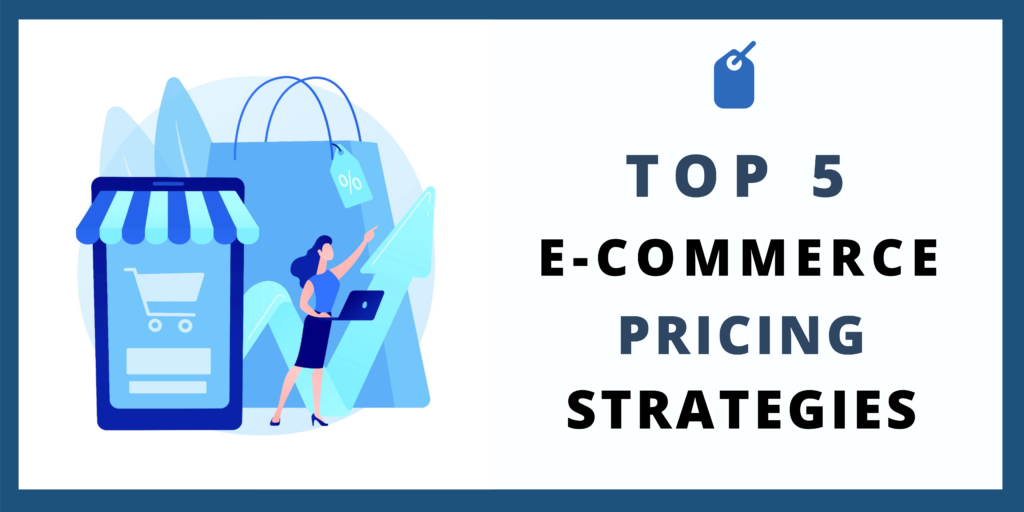The emergence of e-commerce has changed the way we shop. The days of physically going to a store and buying an item are long gone- now, all you require is access to a smartphone or laptop. Online shopping is growing exponentially, as are the products available online. To ensure your distinct mark and generate revenue, you must develop an eCommerce pricing strategy that works for you.
The average eCommerce business loses 6% of its annual revenue to price mistakes, according to Kinsta. An effective eCommerce pricing strategy reduces this loss to a fraction of that. As such, every e-commerce seller needs to have a pricing strategy for every platform.
You Should learn from your competitor, but never copy. Copy and you lose Authenticity
Jack Ma
Discover the best pricing strategy by testing a couple of ideas on your own to establish fundamentals. To begin, you must determine how much it costs to produce the item. If you are selling items yourself, this means finding out what it costs you in terms of labor and materials to make each unit. Then you can decide whether to factor this in or not when deciding on a price for your goods.
The right eCommerce pricing strategy for your online store will depend on the following factors; Marketing & Operating expenses along with Production costs, Competition and Market forces, and Customer value.
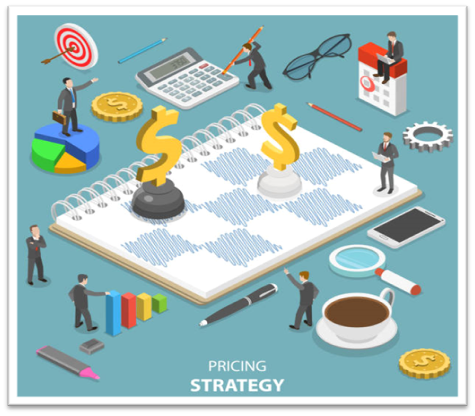
In this article, we will learn the 5 best pricing strategies used widely by e-commerce stores. Also, explore how you can utilize each of these in your own business to ensure you are getting your buck’s worth. But let’s first understand the inner workings of pricing;
Table of Contents
What is the purpose of an eCommerce pricing strategy?
Pricing is a process of mathematically or psychologically addressing and satisfying the consumer’s wants. Knowledge of the marketing mix, i.e., ‘7P’s’ and ‘4P’s’ of Marketing: Price, Product, Place, Physical Environment, Promotion, Process, and People, is crucial. This mix will help you define a profitable price for your product/service.
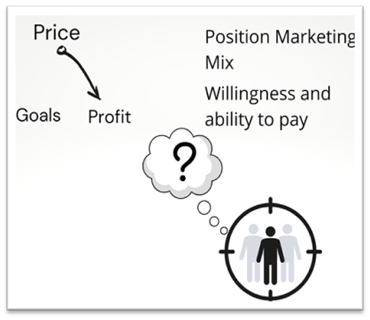
None of the 4P or 7P should be decided in isolation. However, price is the P that we are going to focus on in this blog. So what is the purpose of pricing strategy, and why is it essential to charge the right price? There are many reasons for setting the right price matters to the success of the brand. Firstly, we need to ensure that the price makes sense to our chosen target group and that they perceive the price to correspond to the way the brand image is positioned in their mind.
Let’s take a look at the 7Ps of Marketing that are essential to determine the price of the product:
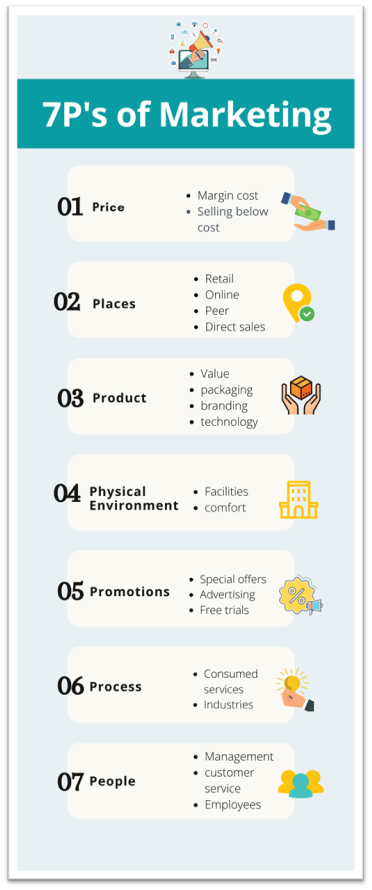
Drawing a link back to the other marketing mix elements, we need to ensure that the price aligns with all other aspects of the mix.
- Firstly, we need to check the financial circumstances of the chosen target group and how likely they are to value the services. Then, brands need to charge a price according to their selected target group, i.e., is both willing and able to pay.
- Secondly, when looking over the strategies and objectives with the product or services, in this case, one also needs to make sure that the price chosen supports the goal set out to achieve with the brand.
- Finally, we need to ensure that the brand generates adequate income to cover its costs and preferably make a healthy profit either in the short term or long term, depending on the strategy.
5 pricing strategies to run a successful E-commerce Business
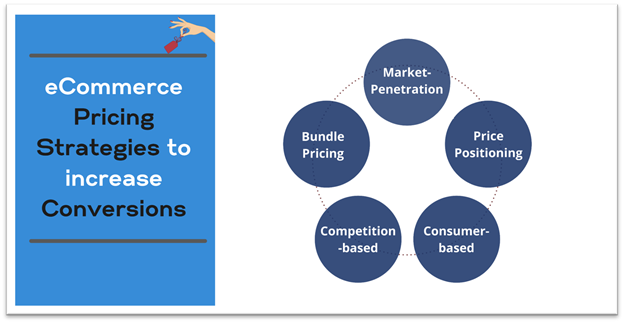
1. Market-penetration eCommerce pricing strategy
Most e-commerce stores do the same thing; they just look at the prices on their competitor’s site and match them. While that may be effective, it doesn’t change that most shoppers do a lot more research and comparison before purchasing.
As an e-commerce store owner, the most common dilemma you might face is whether to increase or decrease the price or not change at all. You are not alone. Everyone with an online store is in the same boat
Pro Tip: Find answers to your every question before you go further setting up pricing for your store. This guide will answer all your essential questions to help you in every store.
‘Everyone loves streamline process.‘
Determine your ideal customer and their characteristics
First, comprehend the customer profile and pick out the particular traits you identify to connect with those traits. Then, bifurcate them based on age, location, and work profile, and keep them in mind to establish your business goals, expenditure budget, revenue, and background.

After establishing these fundamentals, your ideal customers should be able to afford your products. To drive sales and profits, you will need the leads to convert!
E-commerce companies can use their tracking and comparison software to collate the profile data and determine which targeted customers will likely remain loyal and buy your product.
Paxcom has its own in-house Digital shelf analytics software called ‘Kinator’ to help gain real-time insights on product prices, promotions, stock availability, and other data you can use to optimize your pricing strategy on the go
Analyze reviews and feedback
You should take advantage of your existing customers and improvise your pricing strategy by constructively utilizing all the negative reviews into something positive.
.
When you look at the existing customer data, find a common point to analyze the solutions further. Customer reviews are extremely valuable even when used as a simple guide to setting prices accurately for various products
This can be done through sentiment analysis, a crucial tool that analyzes data on a scale far beyond what hand-operated analysis could do, with unsurpassed accuracy and in real-time. It allows brands to make data-driven decisions.
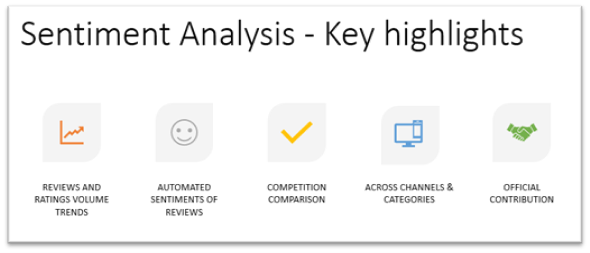
For instance, if your brands get consistently good reviews and have a fair share of loyal customers, you can test the waters, set your products’ prices high, and still get strong sales.
Here is an example of a data-driven report of sentiment analysis to determine the brand position in the market;
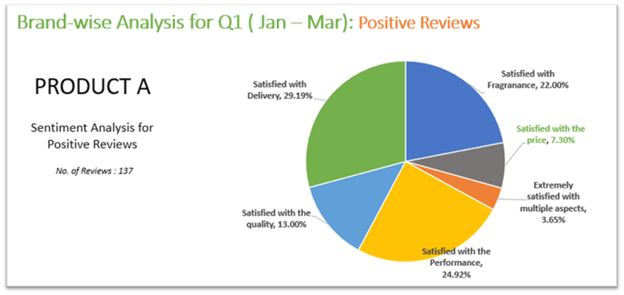
Personalization for eCommerce pricing strategy
Personalization for eCommerce pricing strategy is the act of customizing your offers based on your customers’ personal information. This ensures that you can offer products and services and set prices in a way that engages with them.
It is a brilliant strategy that uses customer data to set the price. It works by matching your customers with their most likely competitors and estimating how much they would be willing to pay for a similar product or service. Personalization allows you to extract as much value from every customer through an intelligent pricing strategy.
Identify Customer pattern
Customer behavior for pricing strategy is important to know what your customer needs. For example, how do they react when facing low prices from competitors? What do they want? How often do they visit the same brand to buy a product or service? Do they look for different value propositions based on how much they spend etc.?
A study conducted by Yieldify observed that consumers really believe in the personalization paradox. 63% expect brands have up-to-date information on their preference, and 66% of millennials are more than happy to share their data in return for more personalized experiences. In addition, being upfront with shipping charges and policies has made the brand see an increase in conversion rate by 42.2%.
All these questions above can be answered by thorough market research, and we also must take their emotions into account when developing a pricing strategy. We should also identify and understand customers to set the price that will make them happy because they are the ones who will turn leads into conversions. USP and competitive analysis help us create a pricing strategy that aligns with the business goals while meeting the expectations and making them loyal to your brand.
2. Price positioning Strategy
A price positioning strategy is all about offering pricing to customers as a branding tool. It helps e-commerce brands to build value in their products by providing competitive pricing. In addition, it provides a way to communicate with customers about what they can expect from using their product and defining USP.
Purpose: To increase the market share and profits of a firm by creating a solid brand image and differentiating it from other brands
Advantage: This allows you to cater to both high and low-end customers without tarnishing your brand reputation. It can help you gain sales and reduces competition with other brands.
Things to consider before implementation: Identifying target customer, Analyze the competitors in the market.
Additional Note: This strategy requires a brand to position its products in specific price segments. It can also be called value-based pricing as it focuses on the perceivance of the consumers.
3. Consumer Psychology behind your eCommerce Pricing strategy
Consumer psychology study helps you to identify their likes and dislikes. Pricing decisions are generally made by taking into account their perception of the product, not just by the cost of producing it.
A study on consumer psychology behind online shopping is carried out with a review of the significant findings, it is suggested that there are five groups of consumers with five different price-related behaviors in the context of e-commerce: Consumers who buy because they like the brand, Consumers who buy because they like to get free shipping, Consumers who buy because it’s a good deal, Consumers who buy as a means to show off, Consumers who buy for convenience.
These actionable insights will help you make decisions for setting up a profitable pricing strategy.
4. Research your competition
Researching the competition is an important step that most brands overlook because it’s time-consuming and requires much effort. However, it is imperative to do this because the actions of your competitors will tell you what you need to do next. In addition, it is an efficient way to increase your sales and the average order value. While it’s a relatively new technique, it’s proven to be more effective than many other strategies. Competitor-based pricing is not just about choosing lower prices than competitors; you need to select the right products, select the best price points for your offer and make sure your customers understand how to offer better deals.
Examining their principles and creating a strategy for your own with that analysis gives you an edge over others in the industry. You will know what they are doing, so you can avoid making mistakes they made or even capitalize on their mistakes and become better than them at certain things.
Purpose: If you are new in the business. Researching your competition allows you to know their pricing, distribution, and promotional tactics. You can use this data to make an informed decision about your brand.
Advantage: Offers you more visitors and a chance to win more customers; keeps your game afloat with constantly changing trends.
5. Bundle pricing
A bundle pricing mixes two or more products combined for a lower price than the sum of their expenses. The bundle pricing strategy is used to increase revenue by drawing attention to the product package’s total value and reducing overall shipping costs by offering multiple items in one shipment.
For instance, The image below shows perfectly devised pencil accessories consisting of grips, nibs cover, and replacement caps; and you can see if it had been a single item, it would have cost the same, but when bundled together, it gives the customer a ‘cheat deal’ feel and ultimately boosts your sales and helps in moving up your inventory.

Advantage: You can charge customers a lower price when they buy several items, increasing your sales, and this positively impacts customers’ minds because they save money on shipping when purchasing multiple items.
This method works best when it includes products that are complementary rather than similar. The customer gets more value for the money spent, resulting in higher customer satisfaction through increased perceived value. It also offers more choice to the customer, thus providing flexibility in their purchase decision.
The inspiration behind this eCommerce pricing strategy: To enhance sales of lesser-selling items by bundling with higher-selling items. Buyers can get more value than they would by purchasing a single thing.
Factoid: Also known as package pricing, package deal, or family discount.
Parting Thoughts
E-commerce is already overcrowded, with replacements available for every product. Therefore, it is crucial to carry out the trial-and-error process. The plan you choose should be based on your business goal and marketing strategy, not just rely on competition market research.
Remember, once you build loyalty, people will buy premium products at a high price because there is no certainty that people will buy if you lower your product rates. So, it should be a mixture of trust and connection with them.
Price creates an image in customers’ minds about the quality, product, and service your brand offers, which directly affects your conversion rate. So connect with consumers and get it done right.
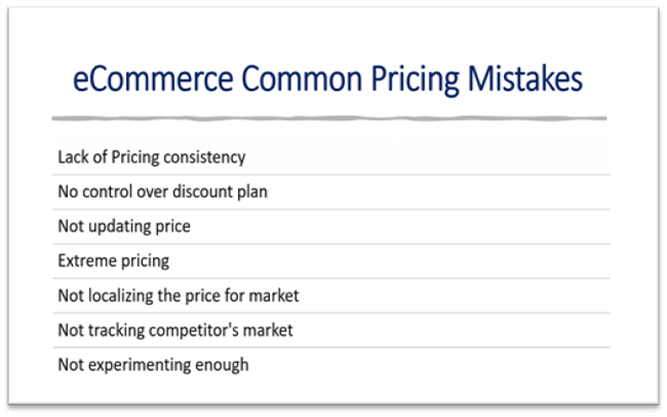
Paxcom’s take on Optimized eCommerce pricing strategy
The eCommerce pricing strategy is not a simple formula, but it is a complex process that requires experimentation and experience. There are many different strategies out there, including cost-plus, value-based, competitor-based, and customer-based. When creating a pricing strategy for your business, it’s essential to consider your customers’ needs and best meet them. By doing this, you can ensure that your company is profitable and successful in reaching its goals.
We are a multi-disciplinary team with e-commerce, development, business, and marketing experts to manage and facet all your requirements. Collaborate and let us help you make your e-commerce business a successful one.
If you would like to know more about pricing strategies and various marketing and development segments, please reach us at info@paxcom.net.
